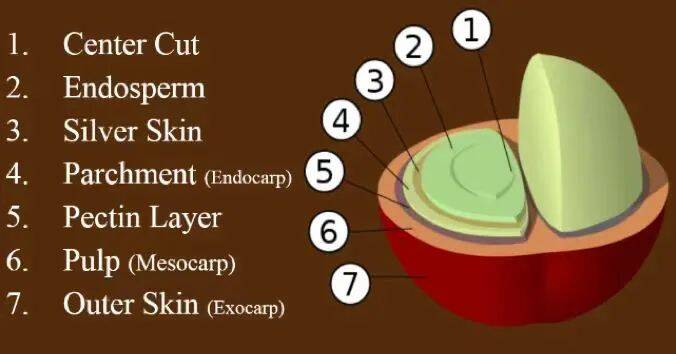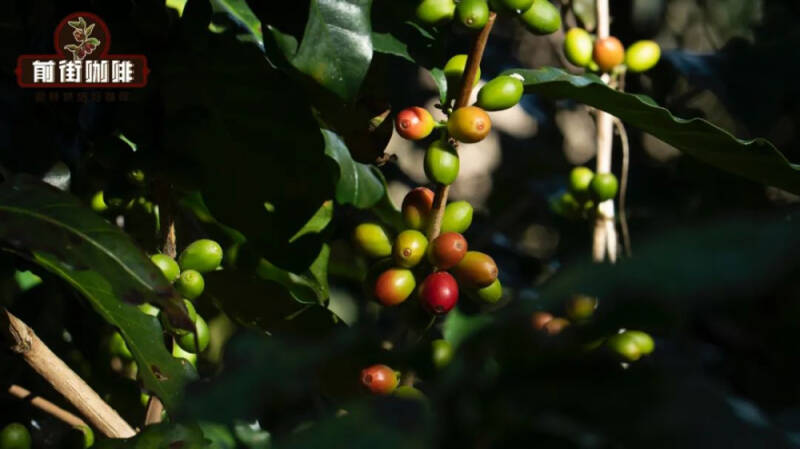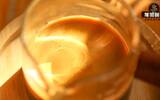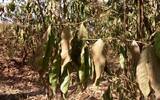What is the relationship between coffee fruits and coffee beans? Dissect the structure and composition of coffee! How much caffeine does a coffee bean have?
Since Qianjie often mentions some nouns related to coffee fruits and beans, which makes it difficult for many friends who are not familiar with fruits and beans to digest them, so today we will share the structure of coffee fruits and beans again, in order to help you better digest the main points in the article.
The composition of coffee fruit below is a common anatomical picture of coffee fruit, a fruit is mainly divided into seven parts, from the outside to the inside is: ⑦ exocarp, ⑥ pulp, ⑤ pectin layer, ④ parchment, ③ silver skin (the film between coffee beans and parchment), ② core (coffee beans), ① midline (germ).

Exocarp exocarp is the most external substance in the whole coffee fruit. It consists of 1-2 layers of cells, and its structure is very similar to that of biological epidermis, with stratum corneum and stomata. When the coffee fruit is not ripe, the thin wall of the pericarp will contain a large number of chloroplasts, and then when the fruit is ripe, it will be transformed into a colored body, and the color will gradually change from turquoise to red. The more ripe the fruit, the darker the color!

Pulp is reasonable, from a biological point of view, coffee pulp is part of the skin, because it is developed from the ovary wall of the plant. And coffee pulp contains a lot of sugar and acid substances, it is often said that coffee chews very sweet, talking about the sugar from the peel and pulp. But because it is as thin as the peel, it is easy for friends who first taste the coffee fruit to bite on the coffee bean.
Pectin layer when we remove the peel and pulp, we can see a layer of transparent sticky material on the coffee bean, which is the pectin layer. The pectin layer is insoluble in water, and because it has the highest sugar content, it feels sticky and oxidizable. Within a few minutes of removing the coffee pulp, the pectin will gradually change from transparent to yellow. It is important to know that the pectin layer is an important part of fermentation. Take honey treatment as an example, the more pectin retained, the more substances involved in fermentation, which will give coffee beans a higher sense of sweetness and fermentation.
Parchment coffee beans will be covered with a layer of parchment, which is made up of parenchyma cells!
Silver skin is interspersed between sheep's skin and coffee beans, which is a thin plasma membrane. It will fall off when the coffee beans are processed and roasted. It is also a major feature that distinguishes between sun-cured and washed coffee beans.
Core (coffee bean) coffee beans are not only the raw materials for making coffee, but also the seeds of coffee trees. Generally speaking, a coffee fruit will give birth to two coffee beans, one side of which is flat and will stick together. It is worth noting that if the coffee fruit is stunted during its growth, it is likely that it will only hatch an oval coffee bean without a flat surface. In order to distinguish between the two different situations, round beans without flat surfaces are called round beans / beads; beans that hatch normally and with flat surfaces are called lentils / flat beans.
The crack in the middle of the embryonic coffee bean belongs to the germ part, which will develop into leaves and stems after breaking through the skin of the coffee seed.
When we pick the coffee fruit, we will immediately deal with it to remove substances other than coffee beans. So let's take a look at what a raw coffee bean is made of.
Generally speaking, the water content of coffee beans will drop to the range of 10-13% after treatment, and the water will gradually lose with the storage time, or turn directly into steam when baking. They do not have a direct effect on the flavor of coffee.
The highest proportion of polysaccharides in polysaccharide coffee beans is polysaccharide! It accounts for about 35% and 45%. They are the basis of plant fiber and other substances, insoluble in water, tasteless, so they will not directly affect the flavor of coffee. When we finish making coffee, the rest of the coffee grounds are fiber parts made up of polysaccharides.
Lipids are an important component of the golden Crema of Italian coffee, which is mainly composed of linoleic acid, palmitic acid and other oils. Arabica coffee beans will have a higher proportion of lipids than Robusta. Because many aromatic aliphatic carboxylic acids can be melted into lipids, the content of lipids can directly affect the flavor of coffee. In addition, it can also improve the taste of coffee. The more lipids, the more the taste and aroma of the coffee will improve.
Protein coffee beans contain 12% protein. Similarly, it does not directly affect the flavor formation of coffee. (American coffee flower depends on it.)
The sucrose in oligosaccharide / sucrose coffee beans has a key effect on the taste of coffee, and the higher the content of sucrose in coffee beans, the better the coffee will be. However, sugars will continue to be worn away in the baking process, and under the blessing of various reactions, sugars will continue to degrade and regenerate, and then become brand-new flavor substances. Generally speaking, the sucrose content of Arabica coffee beans is in the range of 6% to 9%, while that of Robusta coffee beans is in the range of 3% to 5%.
Chlorogenic acid will bring some acid to coffee, but it is important to know that its acid is not a positive taste, but a negative acid that we often criticize and have a sense of astringency. In addition, it will also bring some bitterness! Chlorogenic acid will be degraded after baking and degraded into quinic acid! Quinic acid is non-volatile, so we can't smell it. A large part of the bitterness of deep-roasted coffee comes from chlorogenic acid. Arabica coffee beans account for 5% of chlorogenic acid at 8%, while robusta coffee beans account for 7% of chlorogenic acid at 11%.
Other organic acids-inorganic acids (phosphoric acid) in addition to chlorogenic acid, coffee beans also contain other acids, whether Arabica or Robusta, these acids account for up to 2%! They are citric acid, malic acid, acetic acid, lactic acid, formic acid, phosphoric acid and so on.
Amino acids in raw coffee beans include aspartic acid and chitosan. Similarly, they account for up to 2% of Arabica and Robusta coffee beans.
The caffeine content of caffeine coffee beans is closely related to the variety of coffee beans and the altitude of planting. The caffeine content of Arabica species is about 0.9-1.4%, while that of Robusta species is in the range of 2-4%. Caffeine can act as an insect repellent, so the lower the altitude, the more caffeine will be secreted, and the higher the altitude, the fewer pests, the less caffeine will naturally be.
-END-
Important Notice :
前街咖啡 FrontStreet Coffee has moved to new addredd:
FrontStreet Coffee Address: 315,Donghua East Road,GuangZhou
Tel:020 38364473
- Prev

Can this make hand-brewed coffee have fat? What role can the lipids of coffee beans play?
Under the high-pressure extraction of the Italian coffee machine, espresso coffee can have a very rich golden color of Crema. This layer of Crema is not only beautiful, but also provides a certain taste for espresso coffee, making it more mellow. So many times we think, if the hand-brewed coffee could have this kind of coffee.
- Next

The drought continues! In the future, Robusta will have a supply gap of 2.7 million bags
Recently, global coffee prices have plummeted as weather improves in many countries, exports increase and international inventories rebound. In the earlier April, due to the drought in Vietnam, Vietnam lacked water resources. The main coffee-producing areas were severely affected by high temperatures. Coffee trees also withered, resulting in a decline in production.
Related
- What effect does Italian American coffee with filter paper have? Will coffee taste better if it is put on filter paper at the bottom of the powder bowl?
- What is the color difference in coffee beans? What are the characteristics of honey processed coffee beans? Why are the anaerobically treated coffee beans uneven in color?
- How does novice Xiaobai quickly get started and make coffee? Newbies learn to make coffee by hand and share the specific steps and process process!
- Costa tea has a shelf life of 100 years?! Expert: Unable to verify
- It's a huge uproar! American milk addition was rejected by Manner employees?!
- Mocha pot coffee bean recommendations| How fine and how much powder should be used for grinding? What parameter ratios do I need to use to make milk with Mocha pot coffee?
- What are the characteristics of the world's top ten coffee beans treated with Costa Rica honey? How to make black honey kadura from Tarazhu Pilon Processing Plant taste good?
- How to make deep-roasted coffee? What grinding water temperature does authentic Jamaica Blue Mountain No. 1 coffee use to brew it well?
- Selected high-grade rose summer coffee flavor tasting guide Why Panama rose summer has the aroma of flowers and fruits
- What equipment does a novice Xiaobai need to buy to learn to make coffee? Filter cup electronic scale bean grinder manual flushing pot purchase guide

